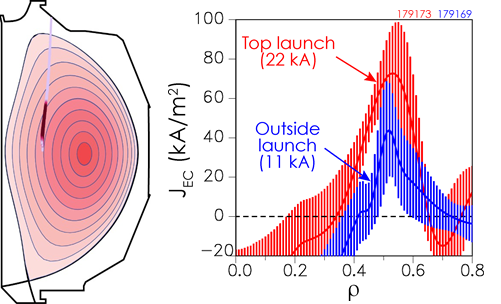Moving on Up, to the Top
New approach doubles the current that can be driven by microwave heating at the DIII-D National Fusion Facility

Image courtesy of Xi Chen, DIII-D National Fusion Facility
The red line (left image) shows how microwaves from a top-launch position align well with the plasma to drive current (dark shading). Graph at right shows that more current is driven with top launch (red) than conventional outside launch (blue).

The Science
Researchers have demonstrated a new approach for injecting microwaves into a tokamak fusion device. One promising fusion technique, electron-cyclotron current drive (ECCD), uses microwaves to help stabilize the plasma while it is being heated on the path to fusion. The new approach to ECCD drives electricity to the plasma twice as efficiently as previous approaches. It works by launching microwaves from the top of the tokamak, instead of the side as with current approaches.The Impact
To be economically feasible, tokamak fusion power reactors require efficient ways driving electric current efficiently in specific regions of the plasma. This technique is known as current drive. The new top-launch approach is twice as efficient as existing current drive methods. The researchers successfully tested the top-launch approach at the DIII-D National Fusion Facility. The results are an important step toward practical fusion energy.Summary
Researchers at DIII-D, a Department of Energy Office user facility, are working on ways to improve ECCD, which uses extremely powerful microwaves to heat electrons in the plasma. ECCD is important because it helps stabilize the plasma as it is heated to temperatures necessary for fusion reactions. Traditionally, the ECCD microwaves were injected from the outside of the tokamak toward the heart of the plasma. Recent computer modeling at DIII-D predicted that moving the injection point toward the top of the tokamak and carefully directing it to precise points away from the center of the fusion would dramatically improve efficiency. Based on that modeling, a team at DII-D designed and installed a new system with the top-launch configuration. This configuration aligns the microwave trajectory with both the magnetic field and energy distribution of electrons in the plasma. This means the microwaves selectively interact with only the most energetic electrons in the plasma. This approach can be twice as efficient as traditional ECCD systems, helping to bring practical fusion energy closer to reality.Contact
Xi ChenGeneral Atomics
chenxi@fusion.gat.com




